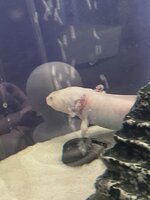Maggie.D
New member
My leucistic axolotl has developed white gills seemingly overnight. His gills aren’t pale, but look as if they have some sort of fungus? I do biweekly water changes and test the water frequently. He hasn’t eaten all of his food the last two times I’ve fed him (although he’s been occasionally refusing pellets since I’ve started feeding him worms) and I’m planning on seeing if he’ll eat a worm tonight. Added Fritz Aquatics Maracyn Oxy to tank after researching and seeing nothing bad for axis. His ammonia is .25 after a water change yesterday and his nitrates and nitrites are both zero. I had an axolotl prior to him who died because of poor water conditions (and an uneducated owner) and I’m noticing the signs with my new axolotl that I noticed with the one previous. I’ve had my axi for five months now and have had minimal problems since then. Any advice would be appreciated!!
(These are the best pictures I could take since he seems to not want to face the front of the tank.)




(These are the best pictures I could take since he seems to not want to face the front of the tank.)
Attachments
Last edited:

